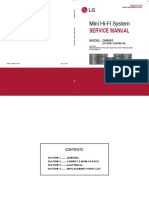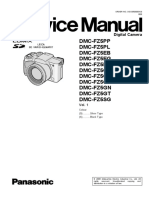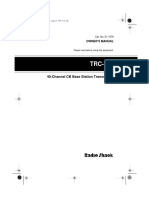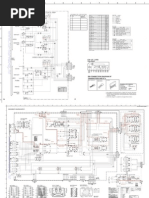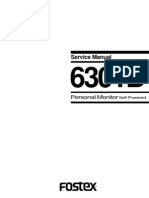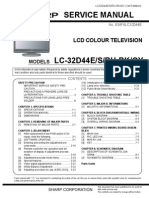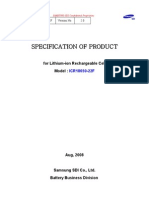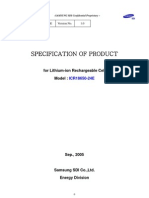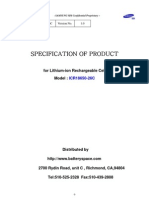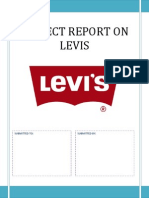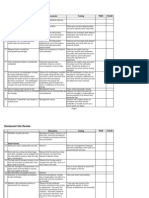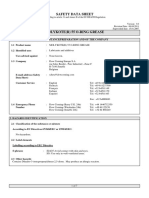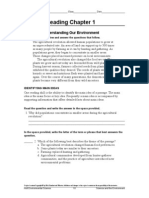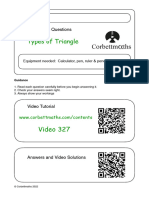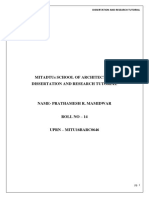ICR18650 26H Samsung
ICR18650 26H Samsung
Uploaded by
Vasil MilchevCopyright:
Available Formats
ICR18650 26H Samsung
ICR18650 26H Samsung
Uploaded by
Vasil MilchevCopyright
Available Formats
Share this document
Did you find this document useful?
Is this content inappropriate?
Copyright:
Available Formats
ICR18650 26H Samsung
ICR18650 26H Samsung
Uploaded by
Vasil MilchevCopyright:
Available Formats
-SAMSUNG SDI Confidential Proprietary
Spec. No.
ICR18650-26H
Version No.
1.0
SPECIFICATION OF PRODUCT
for Lithium-ion Rechargeable Cell
Model : ICR18650-26H
December, 2011
Samsung SDI Co.,Ltd.
Energy Business Division
-SAMSUNG SDI Confidential Proprietary
Spec. No.
ICR18650-26H
Version No.
1.0
History of Revisions
Date
(YY.MM.DD)
Rev. No
11.12.02
Ver. 1.0
Approved by
Quality(CS)
Development
Description
Initial
Simon Shin
Wanmook Lim
Proposed by
Hyorim Bak
-SAMSUNG SDI Confidential Proprietary
Spec. No.
ICR18650-26H
Version No.
1.0
1. Scope
This product specification has been prepared to specify the rechargeable lithium-ion cell
('cell') to be supplied to the customer by Samsung SDI Co., Ltd.
2. Description and Model
2.1 Description
Cell (lithium-ion rechargeable cell)
2.2 Model
ICR18650-26H
3. Nominal Specifications
Item
Specification
3.1 Nominal Capacity
2600mAh (0.2C, 2.75V discharge)
3.2 Minimum Capacity
2550mAh(0.2C, 2.75V discharge)
3.3 Charging Voltage
4.2 0.05 V
3.4 Nominal Voltage
3.5 Charging Method
3.6 Charging Current
3.63V
CC-CV
(constant voltage with limited current)
Standard charge: 1300mA
Rapid charge : 2600mA
Standard charge : 3hours
Rapid charge : 2.5hours
3.7 Charging Time
3.8 Max. Charge Current
2600mA(ambient temperature 25)
3.9 Max. Discharge Current
5200mA(ambient temperature 25)
3.10 Discharge Cut-off Voltage
2.75V
3.11 Cell Weight
47.0g max
Height : 65.00mm max
Diameter : 18.40mm max
3.12 Cell Dimension
Charge : 0 to 45
Discharge: -20 to 60
3.13 Operating Temperature
1 year
:
-20~25(1*)
3 months : -20~45(1*)
1 month : -20~60(1*)
3.14 Storage Temperature
Note (1): If the cell is kept as ex-factory status (50% of charge),
the capacity recovery rate is more than 80%.
2
-SAMSUNG SDI Confidential Proprietary
Spec. No.
ICR18650-26H
Version No.
1.0
4. Outline Dimensions
See the attachment (Fig. 1)
5. Appearance
There shall be no such defects as scratch, rust, discoloration, leakage which
may adversely affect commercial value of the cell.
6. Standard Test Conditions
6.1 Environmental Conditions
Unless otherwise specified, all tests stated in this specification are
conducted at temperature 255 and humidity 6520%.
6.2 Measuring Equipment
(1) Ammeter and Voltmeter
The ammeter and voltmeter should have an accuracy of
the grade 0.5 or higher.
(2) Slide caliper
The slide caliper should have 0.01 mm scale.
(3) Impedance meter
The impedance meter with AC 1kHz should be used.
7. Characteristics
7.1 Standard Charge
This "Standard Charge" means charging the cell with charge current
1300mA and constant voltage 4.2V at 25 for 3hours.
7.2 Standard Discharge Capacity
The standard discharge capacity is the initial discharge capacity of the cell, which is
measured with discharge current of 520mA with 2.75V cut-off at 25 within 1hour
after the standard charge.
Standard Discharge Capacity
2550mAh
7.3 Initial internal impedance
Initial internal impedance measured at AC 1kHz after rated charge.
Initial internal impedance
100m
7.4 Temperature Dependence of Discharge Capacity
Capacity comparison at each temperature, measured with discharge
constant current 520mA and 2.75V cut-off after the standard charge is
as follows.
Charge Temperature
Discharge temperature
25
-10
25
40
Relative Capacity
50%
80%
100%
80%
Note: If charge temperature and discharge temperature is not the same,
3
-SAMSUNG SDI Confidential Proprietary
Spec. No.
ICR18650-26H
Version No.
1.0
the interval for temperature change is 3 hours.
Percentage as an index of the capacity at 25(=2550mAh) is 100%.
7.5 Temperature Dependence of Charge Capacity
Capacity comparison at each temperature, measured with discharge constant current
520mA and 2.75V cut-off after the standard charge is as follows.
Charge temperature
Relative Capacity
25
45
80%
100%
80%
Discharge temperature
25
Note: If charge temperature and discharge temperature is not the same,
the interval for temperature change is 3 hours.
Percentage as an index of the capacity at 25(=2550mAh) is 100%.
7.6 Charge Rate Capabilities
Discharge capacity is measured with constant current 520mA and 2.75V cut-off
after the cell is charged with 4.2V as follows.
Current
0.2C
(520mA)
Charge Condition
0.5C
1.0C
(1300mA)
(2600mA)
Cut-off
7h or 0.05C
2.5h or 0.05C 2.5h or 0.05C
Relative
Capacity
100%
95%
90%
2.0C
(5200mA)
2.5h or 0.05C
80%
Note: Percentage as an index of the capacity at 25(=2550mAh) is 100%.
7.7 Discharge Rate Capabilities
Discharge capacity is measured with the various currents in under table and 2.75V
cut-off after the standard charge.
Current
0.2C
(520mA)
Relative
Capacity
100%
Discharge Condition
0.5C
1.0C
(1300mA)
(2600mA)
95%
90%
2.0C
(5200mA)
80%
Note: Percentage as an index of the capacity at 25(=2550mAh) is 100%.
7.8 Cycle Life
Each cycle is an interval between the charge (charge current 1300mA) with 2.5h or
4
-SAMSUNG SDI Confidential Proprietary
Spec. No.
ICR18650-26H
Version No.
1.0
0.05C cut-off and the discharge (discharge current 1300mA) with 2.75V cut-off.
Capacity after 299cycles and plus 1 day, measured under the same condition
in 7.2
Capacity 1785mAh(70% of the capacity at 25)
7.9 Storage Characteristics
Capacity after storage for 30days at 25 from the standard charge,
measured with discharge current 1300mA with 2.75V cut-off at 25.
Capacity retention(after the storage) 2040mAh (80% of the capacity at 25)
7.10 Status of the cell as of ex-factory
The cell should be shipped in 50% charged state. In this case, OCV is from 3.65V to
3.85V.
8. Mechanical Characteristics
8.1 Drop Test
Test method: Cell(as of shipment or full charged) drop onto the oak-board
(thickness: 30mm) from 1.5m height at a random direction 6 times.
Criteria: No leakage
8.2 Vibration Test
Test method: Cell(as of shipment) is vibrated along 2 mutually
perpendicular axes with total excursion of 1.6mm and with
frequency cycling between 10Hz and 55Hz by 1Hz/min.
Criteria: No leakage
9. Safety
9.1 Overcharge Test
Test method: To charge the standard charged cell with 12V and 2.6A at 25
for 2.5 hours.
Criteria: No fire, and no explosion.
9.2 External Short-circuit Test
Test method: To short-circuit the standard charged cell by connecting positive and
negative terminal by less than 50m wire for 3hours.
Criteria: No fire, and no explosion.
9.3 Reverse Charge Test
Test method: To charge the standard charged cell with charge current 2.6A
By 12V for 2.5 hours.
Criteria: No fire, and no explosion.
9.4 Heating Test
5
-SAMSUNG SDI Confidential Proprietary
Spec. No.
ICR18650-26H
Version No.
1.0
Test method: To heat up the standard charged cell at heating rate 5 per minute up to
130 and keep the cell in oven for 60 minutes.
Criteria: No fire, and no explosion.
10. Warranty
Samsung SDI will be responsible for replacing the cell against defects or poor workmanship
for 15months from the date of shipping. Any other problem caused by malfunction of the
equipment or mix-use of the cell is not under this warranty.
The warranty set forth in proper using and handling conditions described above and
excludes in the case of a defect which is not related to manufacturing of the cell.
11. Others
11.1 Storage for a long time
If the cell is kept for a long time(3months or more), It is strongly recommended
that the cell is preserved at dry and low-temperature.
11.2 Other
Any matters that specifications does not have, should be conferred with
between the both parties.
11.3 PTC Specification
Item
Hold Current
Spec.
2.9A
PTC Specification (in the Cell)
Power
Resistance
Dissipation
7~16m
12. Packing
See Fig.2,
Package Drawing
Max. 2.5W
Resistance
After Trip
Max. 28m
-SAMSUNG SDI Confidential Proprietary
Spec. No.
ICR18650-26H
Version No.
1.0
Max. 18.40
Max. 65.0
Unit : mm
Fig.1. Outline Dimensions of ICR18650-26H
-SAMSUNG SDI Confidential Proprietary
Spec. No.
ICR18650-26H
Version No.
1.0
96 PCS in small box
Tape
Master carton (200PCS)
Fig.2. Package Drawing
-SAMSUNG SDI Confidential Proprietary
Spec. No.
ICR18650-26H
Version No.
1.0
Proper Use and Handling of Lithium Ion Cells
See before using lithium-ion cell
Supplied by
Samsung SDI Co., Ltd.
1. General
This document has been prepared to describe the appropriate cautions and
prohibitions, which the customer should take or employ when the customer uses
and handles the lithium ion cell to be manufactured and supplied by Samsung SDI Co.,
Ltd., in order to obtain optimum performance and safety.
2. Charging
2.1 Charging current
Charging current should be less than maximum charge current specified in
the product specification.
2.2 Charging voltage
Charging should be done by voltage less than that specified in
the product specification.
2.3 Charging time
Continuous charging under appropriate voltage does not cause any loss of
characteristics. However, the charge timer is recommended to be installed
from a safety consideration, which shuts off further charging at time specified
in the product specification.
2.4 Charging temperature
The cell should be charged within a range of specified temperatures in
the product specification.
2.5 Reverse charging
The cell should be connected, confirming that its poles are correctly aligned.
Inverse charging should be strictly prohibited. If the cell is connected
improperly, it may be damaged.
3. Discharging
3.1 Discharging
3.1.1 The cell should be discharged at less than maximum discharge current
specified in the product specification.
3.2 Discharging temperature
3.2.1 The cell should be discharged within a range of temperatures specified in
9
-SAMSUNG SDI Confidential Proprietary
Spec. No.
ICR18650-26H
Version No.
1.0
the product specification.
3.2.2 Otherwise, it may cause loss of characteristics.
3.3 Over-discharging
3.3.1 The system should equip with a device to prevent further discharging
exceeding discharging cut-off voltage specified in the product
specification.(over-discharging)
3.3.2 Over-discharging may cause loss of performance, characteristics, of
battery function.
3.3.3 Over-discharging may occur by self-discharge if the battery is left for
a very long time without any use.
3.3.4 The charger should equip with a device to detect cell voltage and to
determine recharging procedures.
4. Storage
4.1 Storage conditions
4.1.1 The cell should be stored within a range of temperatures specified
in the product specification.
4.1.2 Otherwise, it may cause loss of characteristics, leakage and/or rust.
4.2 Long-term storage
4.2.1 The cell should be used within a short period after charging because
long-term storage may cause loss of capacity by self-discharging.
4.2.2. If long-term storage is necessary, the cell should be stored at lower
voltage within a range specified in the product specification, because
storage at higher voltage may cause loss of characteristics.
5. Cycle life
5.1 Cycle life performance
5.1.1 The cell can be charged/discharged repeatedly up to times specified in
the produce specification with a certain level of capacity also specified
in the product specification.
5.1.2 Cycle life may be determined by conditions of charging, discharging,
operating temperature and/or storage.
6. Design of System
6.1 Connection between the cell and the battery
6.1.1 The cell should not be soldered directly with leads. Namely, the cell
should be welded with leads on its terminal and then be soldered with
wire or leads to soldered lead.
6.1.2 Otherwise, it may cause damage of component, such as separator and
insulator, by heat generation.
10
-SAMSUNG SDI Confidential Proprietary
Spec. No.
ICR18650-26H
Version No.
1.0
6.2 Positioning the battery in the System
6.2.1 The battery should be positioned as possible as far from heat sources
and high temperature components.
6.2.2 Otherwise, it may cause loss of characteristics.
6.3 Mechanical shock protection of the battery
6.3.1 The battery should equip with appropriate shock absorbers in order to
minimize shock.
6.3.2 Otherwise, it may cause shape distortion, leakage, heat generation
and/or rupture.
6.4 Short-circuit protection of the cell
6.4.1 The cell equips with an insulating sleeve to protect short-circuit which
may occur during transportation, battery assembly and /or system
operation.
6.4.2 If the cell sleeve is damaged by some cause such as outside impact,
it may cause short-circuit with some wiring inside the battery.
6.5 Connection between the battery and charger/system
6.5.1 The battery should be designed to be connected only to the specified
charger and system.
6.5.2 A reverse connection of the battery, even in the specified system,
should be avoided by employing special battery design such as
a special terminals.
7. Battery Pack Assembly
7.1 Prohibition of usage of damaged cell
7.1.1 The cell should be inspected visually before battery assembly.
7.1.2 The cell should not be used if sleeve-damage, can-distorsion and/or
electrolyte-smell is detected.
7.2 Terminals handling
7.2.1 Excessive force on the negative terminal should be avoided when
external lead is welled.
7.3 Transportation
7.3.1 If the cell is necessary to transported to order place, such as the
battery manufacturer, careful precautions should be taken to avoid
damage of cell.
8. Others
8.1 Disassembly
8.1.1 The cell should not be dismantled from the battery pack.
8.1.2 Internal short-circuit caused by disassembly may lead to heat generation
and/or venting.
11
-SAMSUNG SDI Confidential Proprietary
Spec. No.
ICR18650-26H
Version No.
1.0
8.1.3 When the electrolyte is coming in contact with the skin or eyes,
flush immediately with fresh water and seek medical advice.
8.2 Short-circuiting
8.2.1 Short-circuit results in very high current which leads to heat generation.
8.2.3 An appropriate circuitry should be employed to protect accidental
short-circuiting.
8.3 Incineration
8.3.1 Incinerating and disposing of the cell in fire are strictly prohibited,
because it may cause rupture.
8.4 Immersion
8.4.1 Soaking the cell in water is strictly prohibited, because it may cause
melt of components to damaged to functions.
8.5 Mixing use
8.5.1 Different types of cell, or same types but different manufacturer's cell
may lead to cell rupture or damage to system due to the different
characteristics of cell.
8.6 Battery exchange
8.6.1 Although the cell contains no environmentally hazardous component,
such as lead or cadmium. the battery should be disposed according to
the local regulations when it is disposed.
8.6.2 The cell should be disposed with a discharged state to avoid heat generation
by an inadvertent short-circuit.
8.7 Caution - The Battery used in this device may present a risk of fire or chemical burn if
mistreated. Do not disassemble, heat above 100 or incinerate. Replace
battery with Samsung SDI battery only. Use of another battery may present a
risk of fire or explosion. Dispose of used battery promptly. Keep away from
children. Do not disassemble and do not dispose of in fire.
8.8 Warning Attached
12
-SAMSUNG SDI Confidential Proprietary
Spec. No.
ICR18650-26H
Version No.
1.0
Handling Precaution and Prohibitions of Lithium Ion & Lithium Ion Polymer
Rechargeable Cells and Batteries
Inaccurate handling of lithium ion and lithium ion polymer rechargeable battery may cause leakage, heat,
smoke, an explosion, or fire.
This could cause deterioration of performance or failure. Please be sure to follow instructions carefully.
1.1 Storage
Store the battery at low temperature (below 20 is recommended), low humidity, no dust and no
corrosive gas atmosphere.
1.2 Safety precaution and prohibitions
To assure product safety, describe the following precautions in the instruction manual of the
application.
[ Danger!]
Electrical misusage
Use dedicated charger.
Use or charge the battery only in the dedicated application.
Don't charge the battery by an electric outlet directly or a cigarette lighter charger.
Don't charge the battery reversely.
Environmental misusage
Don't leave the battery near the fire or a heated source.
Don't throw the battery into the fire.
Don't leave, charge or use the battery in a car or similar place where inside of temperature may be
over 60.
Don't immerse, throw, wet the battery in water / seawater.
others
Don't fold the battery cased with laminated film such as pouch and Polymer.
Don't store the battery in a pocket or a bag together with metallic objects such as keys, necklaces,
hairpins, coins, or screws.
Don't short circuit (+) and (-) terminals with metallic object intentionally.
Don't pierce the battery with a sharp object such as a needle, screw drivers.
Don't heat partial area of the battery with heated objects such as soldering iron.
Don't hit with heavy objects such as a hammer, weight.
Don't step on the battery and throw or drop the battery on the hard floor to avoid mechanical shock.
Don't disassemble the battery or modify the battery design including electric circuit.
Don't solder on the battery directly.
13
-SAMSUNG SDI Confidential Proprietary
Spec. No.
ICR18650-26H
Version No.
1.0
Don't use seriously scared or deformed battery.
Don't put the battery into a microwave oven, dryer ,or high-pressure container.
Don't use or assemble the battery with other makers' batteries, different types and/or models of
batteries such as dry batteries, nickel-metal hydride batteries, or nickel-cadmium batteries.
Don't use or assemble old and new batteries together.
[ Warning! ]
Stop charging the battery if charging isn't completed within the specified time.
Stop using the battery if the battery becomes abnormally hot, order, discoloration, deformation, or
abnormal conditions is detected during use, charge, or storage.
Keep away from fire immediately when leakage or foul odors are detected. If liquid leaks onto your
skin or cloths, wash well with fresh water immediately.
If liquid leaking from the battery gets into your eyes, don't rub your eyes and wash them with clean
water and go to see a doctor immediately.
If the terminals of the battery become dirty, wipe with a dry cloth before using the battery.
The battery can be used within the following temperature ranges. Don't exceed these ranges.
Charge temperature ranges
: 0 ~ 45
Discharge Temperature ranges : -20 ~ 60
Store the battery at temperature below 60
Cover terminals with proper insulating tape before disposal.
[ Caution! ]
Electrical misusage
Battery must be charge with constant current-constant voltage (CC/CV).
Charge current must be controlled by specified value in Cell specification.
Cut-off Voltage of charging must be 4.2V.
Charger must stop charging battery by detecting either charging time or current specified in Cells
specification.
Discharge current must be controlled by specified value in Cells specification.
Cut-off Voltage of discharging must be over 2.5V.
others
Keep the battery away from babies and children to avoid any accidents such as swallow.
If younger children use the battery, their guardians should explain the proper handling method and
precaution before using.
Before using the battery, be sure to read the user's manual and precaution of it's handling.
14
-SAMSUNG SDI Confidential Proprietary
Spec. No.
ICR18650-26H
Version No.
1.0
Before using charger, be sure to read the user's manual of the charger.
Before installing and removing the battery from application, be sure to read user's manual of the
application.
Replace the battery when using time of battery becomes much shorter than usual.
Cover terminals with insulating tape before proper disposal.
If the battery is needed to be stored for an long period, battery should be removed from the
application and stored in a place where humidity and temperature are low.
While the battery is charged, used and stored, keep it away from object materials with static electric
chargers.
Safety Handling Procedure for the Transporter
Quarantine : Packages that are crushed, punctured or torn open to reveal contents should not be
transported. Such packages should be isolated until the shipper has been consulted,
provided instructions and, if appropriate, arranged to have the product inspected and
repacked.
Spilled Product : In the event that damage to packaging results in the release of cells or batteries,
the spilled products should be promptly collected and segregated and the shipper
should be contacted for instructions.
Design of positioning the battery pack in application and charger
To prevent the deterioration of the battery performance caused by heat, battery shall be positioned
away from the area where heat is generated in the application and the charger.
Design of the Battery Pack
Be sure adopting proper safe device such as PTC specified type or model in Cell Specification. If you
intend to adopt different safety device which is not specified in Cell Specification, please contact
Samsung SDI to investigate any potential safety problem.
Be sure designing 2nd protective devices such as PTC & PCM at the same time to protect Cell just in
case one protective device is fault.
Please contact following offices when you need any help including safety concerns.
15
-SAMSUNG SDI Confidential Proprietary
Spec. No.
ICR18650-26H
Version No.
1.0
Samsung SDI Emergency Contact Information
Samsung SDI Headquarter.
575 Shin-dong, Youngtong-gu, Suwon, Kyunggi-do, Korea
Tel:(+82)2-727-3686 Fax:(+82)2-727-3689
Samsung SDI Cheonan factory.
508, Sungsung-Dong, Cheonan City, Chungchongnam-Do, Korea
Tel:(+82)70-7125-1834 Fax:(+82)41-560-3697
Samsung SDI America office.
18600 Broadwick Street Rancho Dominguez CA 90220
Tel:(+1)310-900-5205 Fax:(+1)310-537-1033
Samsung SDI Taiwan office.
Rm. 3010, 30F., 333, Keelung Rd. Sec. 1, Taipei, Taiwan
Tel:(+886)2-2728-8469 Fax:(+886)2-2728-8480
16
You might also like
- Case 3 4 Continued Growth For Zara and InditexDocument3 pagesCase 3 4 Continued Growth For Zara and InditexHarryHakim75% (4)
- UNxx H4200 AGDocument61 pagesUNxx H4200 AGpepe2176100% (1)
- Cyber FX 270 Manual: Click Here To Get FileDocument3 pagesCyber FX 270 Manual: Click Here To Get FileANDERSON SILVA67% (3)
- SM-G955FD Pin Diagram ConnectionDocument60 pagesSM-G955FD Pin Diagram ConnectionSachin Patil100% (1)
- Fork 2007 E150 ENG Instruction GuideDocument9 pagesFork 2007 E150 ENG Instruction GuideCarmen Cámara MedinaNo ratings yet
- Aoc 912vwa+Service+ManualDocument55 pagesAoc 912vwa+Service+ManualtcwsNo ratings yet
- Metal Furring System PDFDocument4 pagesMetal Furring System PDFJane Christy PensergaNo ratings yet
- Technical Manual: Mk5 Battle LightDocument6 pagesTechnical Manual: Mk5 Battle Lightluca ardenziNo ratings yet
- QDT AC Delco N100SMF 12V-100Ah Maintenance Free Battery Spec1Document4 pagesQDT AC Delco N100SMF 12V-100Ah Maintenance Free Battery Spec1Augustine DharmarajNo ratings yet
- Surefire g2 ManualDocument9 pagesSurefire g2 ManualJA SaathoffNo ratings yet
- Leatherman Wave ManualDocument2 pagesLeatherman Wave ManualGuilherme ChiminelliNo ratings yet
- STREAMLIGHT's PROTAC HL® 5-X USB/PROTAC HL® 5-X HANDHELD FLASHLIGHTDocument4 pagesSTREAMLIGHT's PROTAC HL® 5-X USB/PROTAC HL® 5-X HANDHELD FLASHLIGHTTwobirds Flying PublicationsNo ratings yet
- SM G973FDocument102 pagesSM G973FYsrael Agurto SejuroNo ratings yet
- Galaxy S6 Important Management Point - Rev51Document18 pagesGalaxy S6 Important Management Point - Rev51Ion PungaNo ratings yet
- Technology Reference Guide: 2015 Fit EX and EX-LDocument20 pagesTechnology Reference Guide: 2015 Fit EX and EX-LHenry ErazoNo ratings yet
- Disassembly & Assembly Guide of Galaxy S6 - Rev20 - 1506191Document60 pagesDisassembly & Assembly Guide of Galaxy S6 - Rev20 - 1506191Ion PungaNo ratings yet
- LG CM9550Document85 pagesLG CM9550Eliecer GonzalezNo ratings yet
- SM G955F Direy 6 PDFDocument8 pagesSM G955F Direy 6 PDFSlah BahriNo ratings yet
- LG Ld84d Chassis 42lg5000 LCD TV SCHDocument33 pagesLG Ld84d Chassis 42lg5000 LCD TV SCHJoão Pedro Almeida0% (1)
- Sony-Ps2-Scph-39000 Series Service Manual gh-017 gh-019Document30 pagesSony-Ps2-Scph-39000 Series Service Manual gh-017 gh-019LuisNo ratings yet
- KRK-rpg2 Manual PDFDocument20 pagesKRK-rpg2 Manual PDFZoran VlašićNo ratings yet
- SM-G973U - U1 - W Service ManualDocument109 pagesSM-G973U - U1 - W Service ManualWilbert Rivera (figo)No ratings yet
- Pioneer DEH 1330R, DeH 1300R, DeH 1310 Service ManualDocument75 pagesPioneer DEH 1330R, DeH 1300R, DeH 1310 Service Manualmomi201150% (2)
- Panasonic DMC Fz5Document48 pagesPanasonic DMC Fz5IstvanNo ratings yet
- Turbo Gauge Manual PDFDocument24 pagesTurbo Gauge Manual PDFtrikers66650% (2)
- Owner Manual - MVH-S105UI - GS - Asia - Middle - EastDocument80 pagesOwner Manual - MVH-S105UI - GS - Asia - Middle - Eastartinzzz1234100% (1)
- HISS Ignition Key ProgrammingDocument3 pagesHISS Ignition Key ProgrammingDanno NNo ratings yet
- Yamaha HTR 5730 RX v350Document74 pagesYamaha HTR 5730 RX v350yovoc100% (1)
- Hilux Vigo '04: Fog Lamp 6PRS 3.91CFTDocument4 pagesHilux Vigo '04: Fog Lamp 6PRS 3.91CFTjahooha100% (1)
- LSA-Compact 1000W Manual en Rev BDocument44 pagesLSA-Compact 1000W Manual en Rev BahmedNo ratings yet
- .Toshiba Satelilite L675 - LA-6042PDocument58 pages.Toshiba Satelilite L675 - LA-6042PАлександр Ткачук100% (2)
- Samsung UHD 4K HU8500 Series Smart TVDocument4 pagesSamsung UHD 4K HU8500 Series Smart TVWebAntics.com Online Shopping Store100% (1)
- Sony-ps2-Scph-30000 35000 Series Service Manual Gh-013Document35 pagesSony-ps2-Scph-30000 35000 Series Service Manual Gh-013Ernesto justinianoNo ratings yet
- TRC 495 ManualDocument20 pagesTRC 495 ManualRich RitterbuschNo ratings yet
- VHT Special 6 Schematic 5-17-10Document1 pageVHT Special 6 Schematic 5-17-10dennisllanteNo ratings yet
- Technical Bulletin: Camera Wire Color T568A T568B 1 2 3 4 5 6 7 8Document2 pagesTechnical Bulletin: Camera Wire Color T568A T568B 1 2 3 4 5 6 7 8Mohran HakimNo ratings yet
- Surefire 6PDocument2 pagesSurefire 6PArmySGTNo ratings yet
- Yamaha Receiver Rxv-595 SchematicDocument7 pagesYamaha Receiver Rxv-595 SchematicMauricio Bumba100% (2)
- Model List All PDFDocument11 pagesModel List All PDFSri Kingu Jr.No ratings yet
- SM N960F Direy 6Document10 pagesSM N960F Direy 6Ali AhmedNo ratings yet
- Dillon XL650 Adjustment - FAQDocument2 pagesDillon XL650 Adjustment - FAQTomNo ratings yet
- How To Check The X-Tal Defect Regarding S6 - S6 Edge No Power Issue - Rev11Document2 pagesHow To Check The X-Tal Defect Regarding S6 - S6 Edge No Power Issue - Rev11Ion PungaNo ratings yet
- 9619 Samsung T200M T220M Chassis LS20TDS LS22TDS Monitor LCD Manual de Servicio PDFDocument78 pages9619 Samsung T200M T220M Chassis LS20TDS LS22TDS Monitor LCD Manual de Servicio PDFodelaineNo ratings yet
- Aire Panasonic PDFDocument102 pagesAire Panasonic PDFcastilloNo ratings yet
- Engine ExhaustDocument23 pagesEngine ExhaustRepuesto GeneralNo ratings yet
- Pelican-3315 LEDDocument3 pagesPelican-3315 LEDmurugan.ragul100% (1)
- FOSTEX 6301b Service ManualDocument12 pagesFOSTEX 6301b Service ManualRitekk Dirgo100% (1)
- Level1Repair PDFDocument31 pagesLevel1Repair PDFAnonymous slIaSFVNo ratings yet
- Sharp Lc-32d44e S Ru-Bk Gy - EtDocument136 pagesSharp Lc-32d44e S Ru-Bk Gy - Etlucas22010No ratings yet
- Sony Playstation 2 SCPH 30000 30001 30002 30003 30004 2nd EditionDocument127 pagesSony Playstation 2 SCPH 30000 30001 30002 30003 30004 2nd EditionCesar Hernandez Rosas100% (1)
- Vanspace 3D v3.07+ Templates & DimensionsDocument10 pagesVanspace 3D v3.07+ Templates & Dimensionsurbanyoga2019No ratings yet
- Samsung 2200mah ICR18650-22FDocument17 pagesSamsung 2200mah ICR18650-22FStreet_skNo ratings yet
- Samsung 2800mah ICR18650-28ADocument17 pagesSamsung 2800mah ICR18650-28AStreet_skNo ratings yet
- Samsung 2600mah ICR18650-26ADocument16 pagesSamsung 2600mah ICR18650-26AStreet_skNo ratings yet
- Samsung 3000mah ICR18650-30ADocument14 pagesSamsung 3000mah ICR18650-30AStreet_skNo ratings yet
- Samsung 2400mah ICR18650-24EDocument15 pagesSamsung 2400mah ICR18650-24EStreet_skNo ratings yet
- Samsung 2600mah ICR18650-26CDocument17 pagesSamsung 2600mah ICR18650-26CStreet_skNo ratings yet
- Specification of Product Specification of Product Specification of Product Specification of ProductDocument17 pagesSpecification of Product Specification of Product Specification of Product Specification of Productzuffflor_925748656No ratings yet
- 26JM SamsungDocument20 pages26JM SamsungMartin FernandezNo ratings yet
- Specification of Product: For Lithium-Ion Rechargeable Cell ModelDocument18 pagesSpecification of Product: For Lithium-Ion Rechargeable Cell ModelejdiggerNo ratings yet
- Icr18650 26JDocument19 pagesIcr18650 26JjohnrhoeftNo ratings yet
- Marine Electrics Made Simple or How to Keep the Batteries ChargedFrom EverandMarine Electrics Made Simple or How to Keep the Batteries ChargedNo ratings yet
- CadburyDocument33 pagesCadburyVarun JainNo ratings yet
- Osce 10.6 sp3 AgDocument825 pagesOsce 10.6 sp3 Agthiago587No ratings yet
- Копия Restaurant Site ReviewDocument14 pagesКопия Restaurant Site ReviewАнастасия КруминаNo ratings yet
- CR750-CR751 Controller Troubleshooting Bfp-A8871pDocument72 pagesCR750-CR751 Controller Troubleshooting Bfp-A8871pBarry Weller100% (1)
- Modelo EvAU Inglés 2022Document2 pagesModelo EvAU Inglés 2022JulNo ratings yet
- Thesis Synopsis & Proposal Healing ArchitectureDocument4 pagesThesis Synopsis & Proposal Healing ArchitectureAbinaya Varma0% (1)
- Molykote 55 150g MSDSDocument7 pagesMolykote 55 150g MSDSBurak YILMAZNo ratings yet
- KerisDocument2 pagesKerisFatin Raniahthifal AdiwijayaNo ratings yet
- DLL Checking WeekDocument3 pagesDLL Checking WeekHenmar LaquindanumNo ratings yet
- Secret CB Vol 18Document81 pagesSecret CB Vol 18luistorcatt72No ratings yet
- Sampling and Its TypesDocument8 pagesSampling and Its TypesSadaf RasheedNo ratings yet
- Coriolis Mass Flow MeterDocument8 pagesCoriolis Mass Flow MeterChandan ShahNo ratings yet
- Ecosystem and Biodiversity: Unit 3 Part 3Document11 pagesEcosystem and Biodiversity: Unit 3 Part 3Pooja PatilNo ratings yet
- Agriculture HandoutDocument6 pagesAgriculture Handoutcdavis339No ratings yet
- Modal VerbsDocument8 pagesModal VerbsMily MaciasNo ratings yet
- Foreign Literature Studies Regarding Attitudes Towards ADocument2 pagesForeign Literature Studies Regarding Attitudes Towards Adenden2175% (8)
- Lecture 3.2.1 Stack NewDocument41 pagesLecture 3.2.1 Stack Newdeadlygamer6996No ratings yet
- Three-Sector Theory: First Phase: Traditional CivilizationsDocument1 pageThree-Sector Theory: First Phase: Traditional CivilizationsMohana RamasamyNo ratings yet
- CZBBDocument4 pagesCZBBnirajpdNo ratings yet
- DHM Collection-Instructions Urea-Breath-Test 201902 - UnknownDocument2 pagesDHM Collection-Instructions Urea-Breath-Test 201902 - Unknownjohn mewNo ratings yet
- Types of TriangleDocument11 pagesTypes of TriangleAndrew AmankwahNo ratings yet
- She's Mine by Gia BaileyDocument56 pagesShe's Mine by Gia BaileyManase MunkhondiaNo ratings yet
- Visual LanguageDocument6 pagesVisual LanguagenamanNo ratings yet
- Mobiload 315: Product GuideDocument8 pagesMobiload 315: Product GuideSaheb PalNo ratings yet
- Different Nature of Projects Handled: Development of Bangalore Water Supply & Sewerage System - Stage IV, Phase 2Document6 pagesDifferent Nature of Projects Handled: Development of Bangalore Water Supply & Sewerage System - Stage IV, Phase 2Banerjee SuvranilNo ratings yet
- TUTORIAL - Court House - Courtroom - Indian ContextDocument14 pagesTUTORIAL - Court House - Courtroom - Indian ContextPrathamesh MamidwarNo ratings yet
- UPC Planning Installation and Service Guide EPDOC-X637-En-BDocument87 pagesUPC Planning Installation and Service Guide EPDOC-X637-En-Bramesh subburajNo ratings yet
- Ilovepdf MergedDocument2 pagesIlovepdf MergedIlda KapajNo ratings yet
















